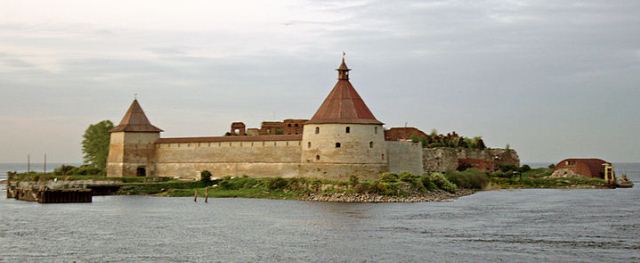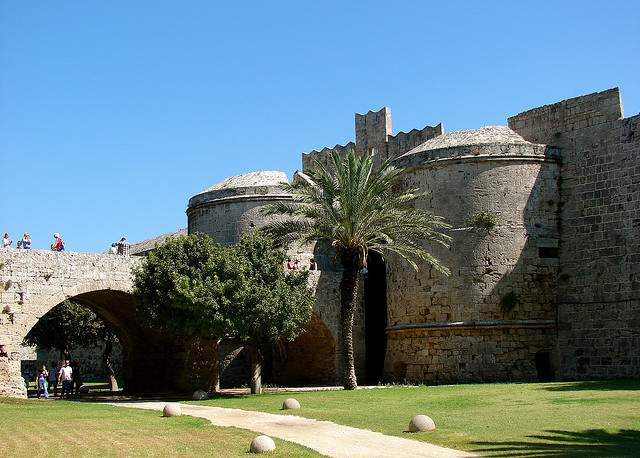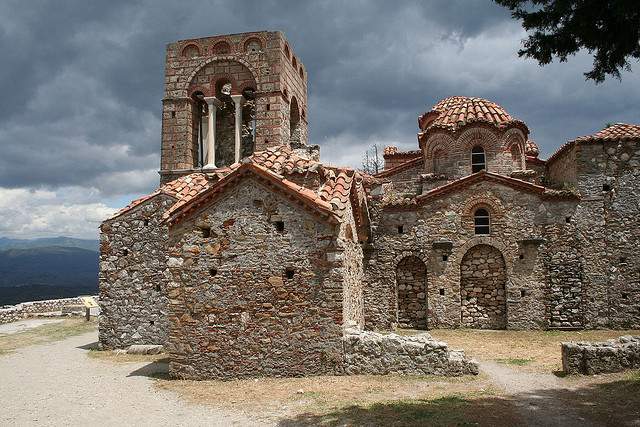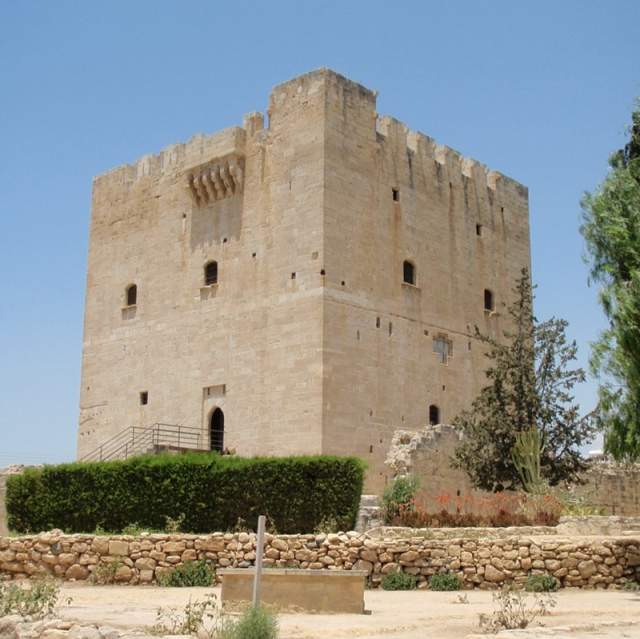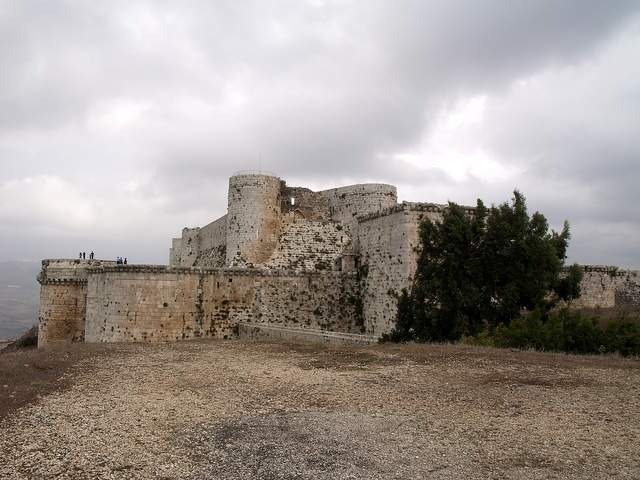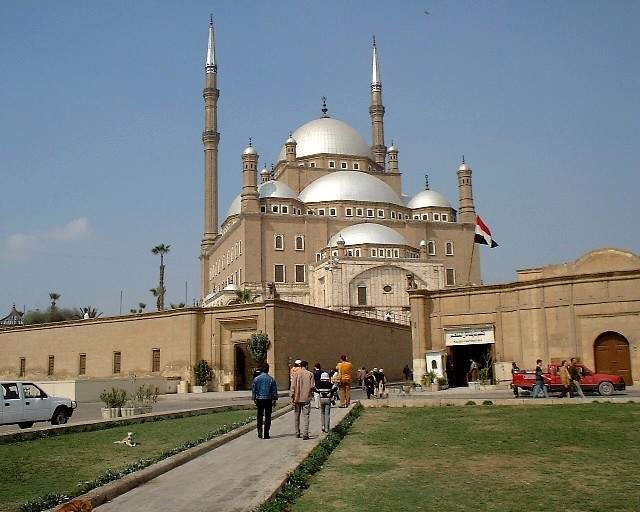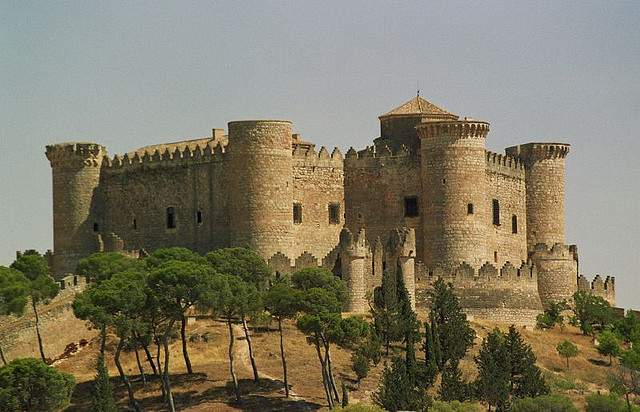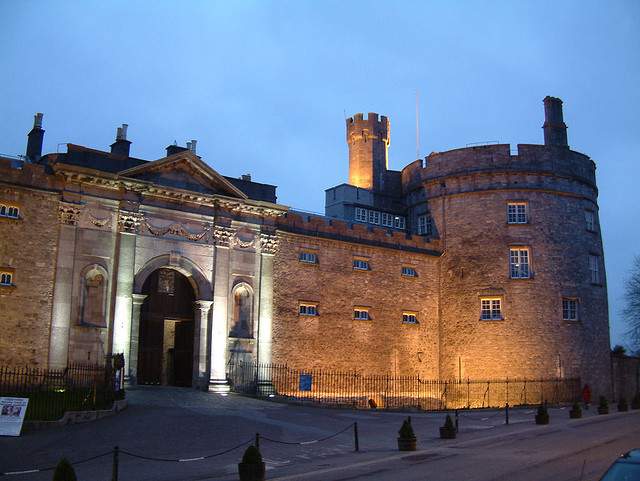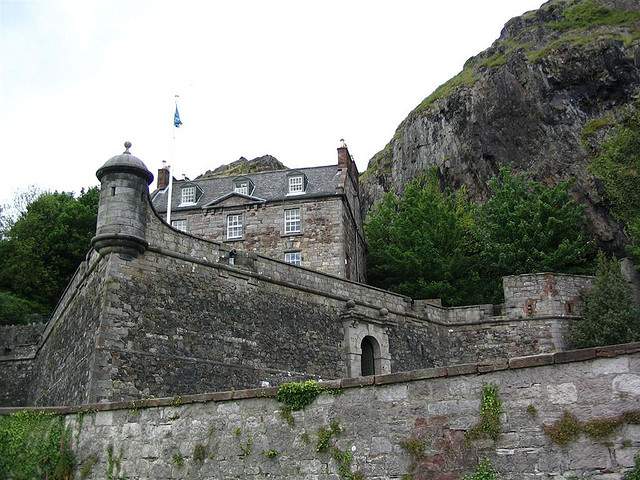People plan trips around many activities: food, hiking, biking, extreme sports, and religious festivals, to name a few. Many people plan RTW travel around historical sites , a good way to understand the history of the places visited and and learn about bygone eras.
Historical sites can mean many different things. But if you’re looking for something unique and interesting to plan a trip around, consider visiting medieval castles. From Syria to Austria and Italy, medieval castles were built between the 5th and the 15th century as private fortified residences of a lord or noble.
Many early castles were made out of timber and earth, later to be constructed in stone (starting with the 9th and 10th centuries). By the 12th century, a scientific approach to defending the castles emerged and proper structural changes were made.
Medieval castles were constructed during the Middle Ages in Europe and the Middle East. They differ from palaces – which are not fortified structures – and fortresses – which are not always residence of nobles or lords. Castles served as center of administration and were a symbol of power. They had both offensive and defensive purposes.
About the itinerary:
When using Indie, BootsnAll’s multi-stop international trip planner, you can customize this trip to make it best for you.
When we searched the above route, the price for airfare was $2549. We searched the following dates: 1st departure is on May 15 , 2013 out of St. Petersburg, Russia. There are 6 days between each flight, and you can certainly arrange those departure days according to your needs. You can try to re-order the cities, but we used this order to make the most of connecting flights.
Oreshek Fortress , Shlisselburg, Russia
Oreshek Fortress –or Shlisselburg for non-Russians – is located on an island in Lake Ladoga at the head of River Neva. The island was first fortified in 1323 and has been the site of territory and trade disputes between Sweden and the medieval principality of Novgorod Velikiy. Other sources say the fortress was built in 1299 and lost to the Novogradians in 1301.
Some of the 14th century fortifications have been excavated and are visible to the public, but the oldest surviving section of the fortress dates from the 16th century.
The admission fee is 160 Rub /US$5 for adults . The fortress can only be visited from May to October, daily from 10 a.m. to 5 p.m.
May, June, September and October are excellent months to visit Russia if you want to avoid the crowds. However, July is particularly interesting in St. Petersburg because there are days when the sun doesn’t set at all (White Nights).
Getting there: Fly into Saint Petersburg then catch a bus to Shlisselburg from Ulitsa Dybenko Metro Station. The bus stops near the ferry terminal from where you can get to the island. The price of the round-trip ferry ticket is 150 Rub / US$4.60 for an adult.
Palace of the Knights, Rhodes , Greece
The Palace of the Grand Master of the Knights of Rhodes (or simply known as Palace of the Knights) was built in the 14th century by the Knights of Rhodes on the site of 7th century Byzantine fortress. After the palace was captured by the Ottomans , it was used as fortress. Unfortunately, the original palace was largely destroyed in an explosion in 1856, but the Italians (after occupying Rhodes) rebuilt it in a grandiose pseudo-medieval style.
The Old Town of Rhodes is the oldest inhabited Medieval town in Europe. The place is located at the end of the Street of the Knights within the Old Town of Rhodes. The street is also a well preserved Medieval relic. It has 158 rooms but only 24 are open to the visitors. The main entrance is to the south façade, flanked by two towers.
The hours when it’s possible to visit vary but during summer expect it to be open from 12:30 p.m. to 7 p.m. on Mondays and 8 a.m. to 7 p.m. from Tuesdays to Sundays. Admission is €6 ($7.80USD) for an adult.
The best months to visit the island of Rhodes are: March to May , October and November. The shoulder season will save money and you won’t need to face the too many tourists or scorching temperatures either.
Getting there: Rhodes is served by an airport, but you can also take a ferry from Athens. Look for accommodation in advance and you can get away with prices starting at €22 ($28.50USD) per night (private twin room with bathroom ensuite) in a place closer to the town and further from the beach.
>>Rhodes is one of the best islands for history buffs
Mystras, Greece
Mystras was built around the fortress erected in 1249 in the municipality of Sparti, Greece. The city of Mystras switched hands many times: from Byzantines to Turks and later to Venetians. It was abandoned in 1832, leaving the incredible ruins and landscape behind. The churches of Mystras have been covered in superb frescos.
The site opens at 8 a.m. It’s a good idea to get here early because there’s a lot of ground to cover. If you are here in July or August, by 11 a.m. it’s already too hot, so plan your visit carefully.
The Greek mainland has a slightly different climate than the Greek islands. The summers are hot and the winters can sometimes be cold and snowy, especially in the mountains. Plan to visit Athens anytime but during the peak summer season (July and August). For cheapest prices choose March, April, September, and October.
Getting there: Fly into Athens and travel to Sparta . It’s a good idea to rent a car from the capital. Mystras is a 15 min drive from Sparta. Book a room in Athens ahead of time and you can get away with €22 ($28.50USD) per night in a double room with private bathroom , especially if you choose to travel during the shoulder season or during winter. Alternatively you can stay in Sparta , especially if you plan to get an early start.
Kolossi Castle, Limasol, Cyprus
Kolossi is the most important medieval castle in Cyprus, located close to Limasol. It is still uncertain when the first fortress was constructed, but it’s known that it dates back to the 13th century. After 1291, the knights of the Order of Saint John transferred their seat of activity to Kolossi.
The fortress was mostly used as an administration seat and as residence, looking over the plantations in the valley around Kolossi and covering about 60 villages. By 1425 the fortress seemed to be already in ruins. But in 1454 a new fortress was constructed, which still exists today.
Today you can visit the castle and tour the sugar-cane factory. Don’t forget to try the wine ,which got its name from the Temple Knights who produced it. The entrance fee is €1.70 ($2.20USD) for an adult (free for children).
Cyprus enjoys a mild climate, similar to the one in Middle East and not as dry as the one in northern Africa. Summers can be very hot, and it’s best to plan the sightseeing vacations in spring or autumn. April, May, October, and November are excellent choices. If you must visit in the summer, plan the sightseeing in the morning.
Getting there: Fly into Larnaca and rent a car for the rest of the journey (about 80 km) to the castle. Alternatively, travel to Limasol and then take a bus to the castle. Book a room in advance and you will pay from €36 ($46USD) per night in a double room with private bathroom.
Enisala Castle , Enisala, Romania
Located just 2 km from Enisala , Yeni-Sale (Enisala, Heracleea) dominates the area between Razlem and Babadag in Romania. It is one of the most impressive medieval fortresses located in the country. The castle was built in the middle of the 14th century and was part of a set of Genovese settlements located all the way to the south of the Crimean peninsula.
Between 1397 and 1416 it was part of Wallachia’s defensive system under the rule of Mircea the Old (n.a. Mircea cel Batran, Romanian). The Turks later conquered it and made it home for a garrison. By the 16th century it was abandoned because it didn’t serve the purpose of defense anymore. The remaining walls are 5-10 meters high and can still be seen easily from a long distance.
After 1991 the walls were restored, and the fortress is now an important tourist attraction in the area. The fortress can be visited from May to September from 10 a.m. to 6 p.m. and from October to April from 8 a.m to 4 p.m. It is closed on Mondays.
Getting there: Fly into Bucharest and travel to Constanta by train, bus, or rental car. Then, it’s a good idea to rent a car and drive to Enisala. Alternatively, you can travel from Bucharest to Tulcea and transfer to Enisala (by bus or rental car). The train from Bucharest to Tulcea takes 5 1/2 hours, and a single ticket starts at €16 ($21USD).
Krak des Chevaliers, Tartus, Syria
Located in Syria, Krak des Chevaliers is a Crusader castle. To this day it remains one of the most important preserved medieval castles in the world. The castle was built and expanded between 1150 and 1250. It guarded the only major path between Antioch (Turkey) and Beirut (Lebanon).
The outside wall has 13 towers and is separated from the keep and inside wall by a moat (filled with water). The chapel in the courtyard was converted in a mosque by Sultan Beybar (after he took over the castle). The Christian frescos have remained undamaged and attract visitors who like medieval art.
The entrance fee is SYP150 ($3.30USD) , discounted for students (SYP 15). The castle is open daily from 9 a.m. to 6 p.m. during summer. In winter, the gates close at 4 p.m. However, please note that the hours change, and it’s best to ask locally.
Syria enjoys a typical Mediterranean climate , which means the best times to visit are the months of April, May, September, and October. The rainfall is low and the temperatures are comfortable ( middle 20Cs).
Getting there: The castle can be easily visited during a day trip from Hama, Homs, or Tartus. Fly into Beirut (Lebanon) and travel to one of those cities. Then take a minibus to the castle. Book a room in Hama in advance, and you can get away with prices from €24 ($31USD) per night in a double room with bathroom en-suite.
The Saladin Citadel of Cairo, Egypt
The Saladin Citadel of Cairo is a medieval Islamic fortification, located in Cairo. Its location offers superb views of the city and surprises the visitor with a lovely fresh breeze.
The citadel was fortified between 1176 and 1183 to protect it from Crusaders. Saladin dreamed of encircling both Cairo and Fustat with a wall for protection, and the citadel was the centerpiece. Long after Saladin’s death the wall was completed, and the citadel has been the seat of the Egyptian government until the 19th century. The Well of Joseph built by Saladin to get water into the fortress can still be seen today.
The entry fee to the citadel is 40 LE ($6.60USD) for foreigners (adults). The site is open from 8 a.m. to 5 p.m. daily. The entry fee includes the possibility to visit the Citadel Prison Museum, National Military Museum, National Police Museum, and the Gohara Palace Museum (palace jewels).
The best time to visit Egypt is between October and May, when the temperatures are not very high. It is; however, when almost everyone comes to Egypt and runs away from the peak season (New Year’s and Easter).
Getting there: The citadel is located in Cairo so you can easily fly here. Take advantage of the days in the city to visit other important landmarks. A deluxe twin room will set you back from €21 ($27USD) per night (in a place close to the Egyptian Museum) if you book in advance and travel outside the peak season.
Belmonte Castle, Cuenca, Spain
Belmonte Castle is a massive medieval castle in Spain, located about 150 km from Madrid. It was built on the hill of San Cristobal, one of the most important historical locations in Spain. It is one of the best preserved Gothic medieval castles.
It started life in the 12th century as a family mansion. By 1323 it was given to Don Manuel, who started building his residence. This old structure is now in ruins. The castle which can be visited today was built between 1456 and 1470. The castle features six cylindrical towers, a courtyard , a balustrade and the royal chambers.
Eugenia, the wife of Napoleon III, decided to come here after her husband died. She began restoring it, and the results are visible to this day.
It’s definitely a good idea to visit Spain during the shoulder season, although summer has its benefits. Aside from the weather being hot , the sites are open for longer, and you can also plan to spend some days on the beach. However, for sightseeing, April, May, September, and October are good choices.
Getting there: Fly into Madrid, and then catch a train into Cuenca. Trains leave about every 3 hours from Madrid and the travel time is 3 hours. The single adult fare starts at €13.85 ($18USD). Alternatively , Avanza runs a bus between the two cities. Buses depart every 2 hours from Madrid, and the travel time is about 2 hours. Single fare starts at €14.25 ($18.50). From Cuenca, travel to Belmonte, where the castle is located. You can find plenty of places to stay in Madrid, with prices starting at €35 ($45USD) per night in a double room (with shared bathroom) and beds in dorms from €10 ($13USD) per night.
The Castle of Gradara , Gradara, Italy
The town of Gradara is characterized by a double line of medieval walls and the castle, one of the best preserved in the country. The construction began in the 12th century. The current castle was finished by the 15th century. The castle is located on the border of Marche and Emiglia Romana.
The guided tour passes through the torture dungeon, the kitchen, the rooms ,the ballroom, as well as through the weapons and armory chamber.
According to the official site, the price is €90 ($117USD) for a guided tour (20 people max, an additional €2 is paid for each person is the group is larger) and €20 ($26USD) surcharge if you choose the tour in another language than Italian. Make reservations in advance.
Spring and Fall are the best times to plan to visit Gradara. The days are warm and sunny. By the end of spring, it’s possible to sunbath. Plan your trip from March to May or from September to November. By the end of fall it’s getting colder and more humid, though.
Getting there: Fly into Bologna , then take a bus to Gradara. Alternatively you can rent a car and drive the 140 km to the castle. Book a room in advance in Rimini (25 km from Gradara) and you’ll pay from €34 ($44USD) per night in a deluxe double room with private bathroom.
Fortress Hohensalzburg , Salzburg, Austria
Most often referred to as a castle, Fortress Hohensalzburg is one of the largest still existing 11th century fortresses in Europe , located in Salzburg , Austria.
The construction began in 1077 and the original design was a simple keep situated on a motte, with a courtyard surrounded by a protective ditch and wood wall. The castle was gradually expended, and in 1462 the ring walls and tours were built. The funicular within the fortress is probably the oldest operational railway in the world (records of it date back to 1515).
The entrance fee is €11 ($14.25USD) for an adult (if you take the funicular and € 7.80 if you take the footpath). The entrance fee also includes: an audio guide tour, visiting the Regency chambers , access to a multivision show, and visiting the on-site museums. In the summer (May to September) the fortress is open daily from 9 a.m. to 7 p.m. During the rest of the year, it’s open from 9:30 a.m. to 5 p.m.
The climate of Austria is continental, typical for Central Europe. For sightseeing and spending time outdoors, it’s best to visit Austria in May or September, when the weather is warm and the days are sunny. You can certainly get cold and rainy days in the summer, just as easily as it can be nice and sunny in April or October.
Getting there: The castle is located in the city of Salzburg, which can be easily accessed by train from Vienna, Austria’s capital. Book a room in Salzburg ahead of time and you will pay from €60 ($78USD) per night in a double budget room with private bathroom. Alternatively, you can choose a bed in a hostel (from €17 – $22USD -per night in an 8-bed dorm).
Also in the area are: Hohenwerfen Fortress and Hochosterwitz Castle (250 km south of Salzburg).
Kilkenny Castle , Kilkenny, Ireland
Kilkenny Castle was built in 1195 to control a fording-point of the River Nore and a junction of several routes. At first, it was a motte-and-bailey castle. In its original condition from the 13th century, it had four large circular corner towers and a massive ditch. Evidence shows that it was a keepless castle (without a keep as main feature).
Today the castle is an example of several phases of architectural development in the country. In the 20th century a large amount of restoration took place as the castle was open to visitors.
The admission charge is €6 ($7.75USD) for an adult ( €2.50 for students). The opening times change according to season: October to February 9:30 a.m. to 4:30 pm; March 9:30 a.m to 5 p.m.; April , May and September 9:30 a.m. to 5:30 p.m.and June to August 9 a.m. to 5:30 p.m..
Considering the weather in Ireland, it’s best to visit the country in spring or autumn. Summers come with high prices and crowds but also with long sunny days. However, spring and fall offer weather in between bad and good, the prices are lower than during peak season, and the crowds either haven’t arrived yet or are gone already.
Getting there: Kilkenny Castle is located in the center of the city and is a 15 minute walk from McDonagh Railway Station. Fly into Dublin, then take a train to Kilkenny (travel time: about 1h 40 min) . Staying in Kilkenny can be a costly choice even during the shoulder season. Instead, you can stay in Dublin. Budget twin rooms with private bathrooms start at €44 ($57USD) per night if booked in advance.
>>Kilkenny Castle is part of this 10 days itinerary in Ireland
Dumbarton Castle, Dumbarton, Scotland
Overlooking the town of Dumbarton, the castle is the oldest stronghold in the UK . It sits on a plug of volcanic basalt and has become an important royal castle during the Middle Ages. When it was built around 1220s, it controlled the border with Norway (which was just 10 miles downriver).It is said that during the Wars of Independence with England, William Wallace might have been held prisoner here.
The castle offers stunning views all the way to the peak of Ben Lomond.
The admission fee is £4.50 for an adult . During summer (April to September), the castle is open daily from 9:30 a.m. to 5:30 p.m. During October it is open daily from 9:30 a.m. to 4:30 p.m. and during winter it’s open daily except on Thursday and Friday, from 9:30 a.m. to 4: 30 p.m.
The best time to visit Glasgow is between March and August, when the days are warm and the sun stays longer in the sky.
Getting there: Dumbarton Castle can be easily reached by train from Glasgow . Fly into Glasgow and then travel 30 min to the town of Dumbarton. Book a hostel private room in advance in Glasgow and you’ll pay from £24 ($31USD) per night for a private double room.
Also in the area you can find Blair Castle, located near the village of Blair Atholl, a 2 hour train ride from Glasgow. The castle is said to be started in 1269 and the oldest part of the castle is the Comyn’s Tower , which still retains some fabric from the 13th century.
>>Blair Castle is also featured in this 10 days Itinerary in Scotland
Every week, on “Round the World Wednesday” we share tips for planning, budgeting and selecting a route, plus advice on where to go and what to see and do all around the world.
